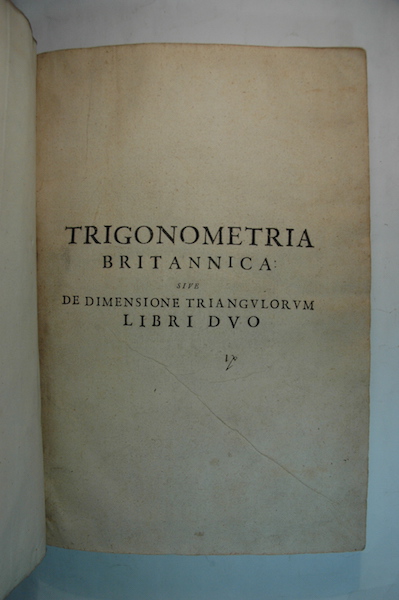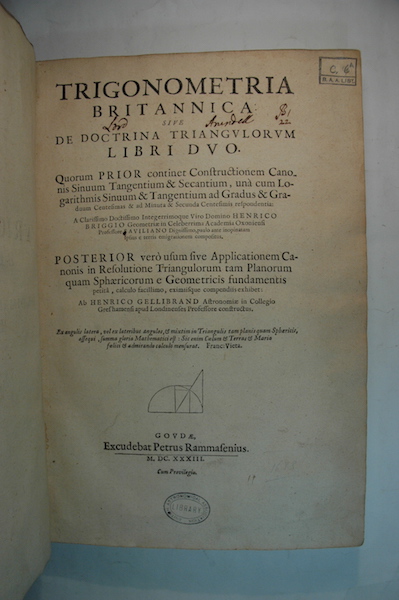BRIGGS, Henry
THE FIRST COMPLETE SET OF TRIGONOMETRICAL TABLES
Trigonometria Britannica: sive De doctrina triangvlorvm libri dvo [etc.]
Gouda, Pieter Rammazeyn, 1633£5,750.00
FIRST EDITION. Fol., pp. [viii] 110, [cclxxiv]. *4 A-N4, O3, a-y6, z4, (lacking O4 blank), leaf with corrections inserted after F2. Roman & italic letter, geometric device on t.-p., numerous geometrical diags., woodcut initials & grotesque headpieces, 272 pp. of tables, contemp. autograph ‘Lord Arundell’ at head of t-p with his ms. shelf mark, C18 Arundell bookplate on pastedown, two stamps of the British Astronomical Association in margin of t-p. Light age yellowing, small ink stain to very outer blank margin of four ll. A very good, clean, well margined copy in contemporary English calf, sympathetically rebacked c. 1900, covers bordered with single blind and gilt rules, spine with raised bands, gilt ruled in compartments with gilt fleurons, all edges speckled red.
1st edn. of the first complete set of trigonometrical tables, “containing the natural sines, tangents and secants to the one hundredth part of a degree and to 15 places, which have never been superseded by any subsequent calculations”. The work arose out of discussions between Briggs, professor of geometry at Gresham College, and the great Scots mathematician John Napier, the inventor of logarithms, who in 1614 had published his ‘Mirifici Logarithmorum Canonis Descriptio’. Napier agreed to suggestions by Briggs for adapting his invention more readily to the construction of tables, and the result, entailing prodigious labour, was Briggs’s ‘Arithmetica Logarithmica’ (1624) and the present work. It is clear that the scale of logarithms now in use, in which 1 is the logarithm of the ratio 10 to 1; 2 that of 100 to 1, etc., is due to Briggs, and that Napier’s role consisted simply in advising him to commence at 1 and make the logarithms increase, rather than decrease, with the natural numbers. Briggs is certainly the originator of the principle of logarithms having 10 for their base.
On his death in 1630 the ‘Trigonometria’ was still unfinished, but was completed by his friend Henry Gellibrand, professor of astronomy at the same college, who added a preface explaining the application of logarithms to plane and spherical trigonometry. They also proved highly useful in the advance of systematic geography and navigation, and among the pioneers in this field who benefited from Briggs’s friendship and special knowledge were Samuel Purchas, Capt. Luke Fox and Edward Wright.
“He [Briggs] was a man of the first importance in the intellectual history of his age… He published many books on arithmetic, geometry, and trigonometry, as well as tables for navigation…. But, significant though Briggs was as a mathematician in his own right, his greatest importance was as a contact and public relations man”. He was at the center of a group that included William Gilbert, Edward Wright, Thomas Blundeville, Aaron Rathborne, Mark Ridley, Robert Hues, Hackluyt, and John Pell amongst many. “Briggs seems to have been the first person to appreciate the significance of Napier’s invention of logarithms …and from his interview with Napier onwards Briggs used all Gresham College’s resources to popularise this discovery… It has recently been claimed that in calculating his logarithms Briggs used results equivalent to the Binomial Expansion, whose discovery is normally attributed to Newton.” ..”Gellibrand (1597-1637) another friend and protégé of Brigg’s, completed his master’s work on logarithmic trigonometry tables: wrote on navigation; and demonstrated the secular variation of magnetic declination. His work was known to Mersenne. ” C. Hill. Intellectual Origins of the English Revolution.
A very good copy with excellent provenance; Lord Arundell of Wardour (1606- 1694) commanded gallantly for Charles I in the civil war, was employed by Charles II in arranging the negotiations for the secret Treaty of Dover with Louis XIV, was imprisoned for five years in the Tower during the Titus Oates hysteria, appointed Keeper of the Privy Seal under James II and remarkably died in his bed at the age of 88.
Shaaber B 661. Smith, \\\\\\\'Rara Mathematica\\\\\\\' p. 621. Honeyman 506. Graesse I 540. Brunet I, 1258.In stock





